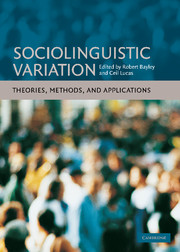Book contents
- Frontmatter
- Contents
- 1 List of figures
- 2 List of tables
- Acknowledgments
- Notes on editors and contributors
- Introduction
- Part 1 THEORIES
- Part 2 METHODS
- Part 3 APPLICATIONS
- 12 Sociolinguistic variation and education
- 13 Lessons learned from the Ebonics controversy: implications for language assessment
- 14 Variation, versatility, and Contrastive Analysis in the classroom
- 15 Social-political influences on research practices: examining language acquisition by African American children
- 16 Sociolinguistic variation and the law
- 17 Attitudes toward variation and ear-witness testimony
- Afterword: Walt Wolfram and the study of sociolinguistic variation
- References
- Index
17 - Attitudes toward variation and ear-witness testimony
Published online by Cambridge University Press: 16 February 2010
- Frontmatter
- Contents
- 1 List of figures
- 2 List of tables
- Acknowledgments
- Notes on editors and contributors
- Introduction
- Part 1 THEORIES
- Part 2 METHODS
- Part 3 APPLICATIONS
- 12 Sociolinguistic variation and education
- 13 Lessons learned from the Ebonics controversy: implications for language assessment
- 14 Variation, versatility, and Contrastive Analysis in the classroom
- 15 Social-political influences on research practices: examining language acquisition by African American children
- 16 Sociolinguistic variation and the law
- 17 Attitudes toward variation and ear-witness testimony
- Afterword: Walt Wolfram and the study of sociolinguistic variation
- References
- Index
Summary
Introduction
Can the telephone be used as an instrument of racial discrimination? Can a landlord, or someone selling property, detect a speaker's racial background from the sound of his or her voice over the phone, and then deny that person the opportunity to rent or purchase the property in question? Our experimental results and other anecdotal evidence suggest that the answer is “Yes.” Moreover, the courts are ill-equipped to offer adequate legal redress to anyone who falls prey to linguistic profiling at the hands of housing providers or, for that matter, lending institutions and insurance companies.
This paper explores the concepts of linguistic profiling and “ear-witness testimony” in cases that call for voice identification, and does so being mindful of research traditions that study language attitudes. Of greatest interest to readers of this volume, linguistic profiling has been shown to have a detrimental impact on our collective quest to advance equal access to fair housing and fair lending. We begin with a review of previous awareness of this problem, including the important role of quantitative and experimental studies of language attitudes, and conclude with some of the legal challenges to discrimination based on language usage, as well as implications for future research.
My research on this topic grew out of personal experience. As a young scholar, I had an opportunity to spend a sabbatical at the Center for Advanced Study in the Behavioral Sciences in Palo Alto, California. Upon moving to Palo Alto, I found that the apartment I had rented didn't fully meet our needs.
- Type
- Chapter
- Information
- Sociolinguistic VariationTheories, Methods, and Applications, pp. 338 - 348Publisher: Cambridge University PressPrint publication year: 2007
- 7
- Cited by

